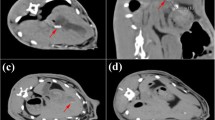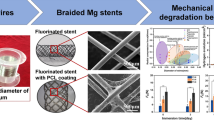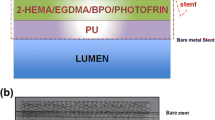Abstract
Biodegradable magnesium alloy implants have attracted much attention because of their excellent biocompatibility and good mechanical properties. However, effects of Mg alloy on cell apoptosis remain unclear. The aim of this study was to investigate the effects of the Mg-6Zn alloy on the apoptosis and necrosis of common bile duct (CBD) epithelial cells. In the in vitro experiments, primary mouse extrahepatic bile epithelial cells (MEBECs) were exposed to Mg-6Zn alloy extracts with different concentrations (0, 40, 80, and 100 %). Flow cytometry analysis indicated that low concentration Mg-6Zn extract can induce apoptosis of MEBECs, and high concentration Mg-6Zn extracts may relate to necrosis and/or ‘apoptotic necrosis’. Real-time PCR results showed that when MEBECs were treated with 40 % extracts for 3 days, the relative apoptotic genes including Bax, Bax/Bcl-2 ratio, NF-κB and caspase-3 were higher than those in the control group. In the in vivo experiments, Mg-6Zn alloy stents were implanted into rabbits’ CBD for 1, 2, 3 weeks, respectively. Based on the hematoxylin and eosin (H&E) staining of peri-implant CBD tissue, no apoptotic bodies and necrotic cells were observed. Results of immunohistochemical staining also showed Mg-6Zn stents did not increase expression levels of apoptosis related gene such as Bax, Bcl-2, Bax/Bcl-2 ratio, TNF-α, NF-κB and caspase-3 in CBD, which indicating Mg-6Zn did not induce significant apoptosis in the in vivo experiments. The different results of in vitro and in vivo experiment may result from the low corrosion rate of Mg-6Zn alloy stents in vivo and local Mg2+ ion concentration in CBD.







Similar content being viewed by others
References
Bartsch I et al (2012) In vivo fluorescence imaging of apoptosis during foreign body response. Biomaterials 33(29):6926–6932
Casiano CA, Ochs RL, Tan EM (1998) Distinct cleavage products of nuclear proteins in apoptosis and necrosis revealed by autoantibody probes. Cell Death & Differ 5(2):183–190
Chai C et al (2010) A novel method for establishment and characterization of extrahepatic bile duct epithelial cells from mice. Vitro Cell Dev Biol Anim 46(10):820–823
Chen Y et al (2013a) In vitro and in vivo assessment of the biocompatibility of an Mg-6Zn alloy in the bile. J Mater Sci Mater Med 25:471–480
Chen Y et al (2013b) Technique for the safe placement of a biodegradable stent into the common bile duct of rabbits. Exp Ther Med 6(5):1101–1104
Chen Y et al (2014) In vitro and in vivo corrosion measurements of Mg–6Zn alloys in the bile. Mater Sci Eng: C 42:116–123
Daldoul S, Moussi A, Zaouche A (2012) T-tube drainage of the common bile duct choleperitoneum: etiology and management. J visc surg 149(3):e172–e178
D’amelio M, Cavallucci V, Cecconi F (2009) Neuronal caspase-3 signaling: not only cell death. Cell Death Differ 17(7):1104–1114
Delhalle S et al (2003) An introduction to the molecular mechanisms of apoptosis. Ann N Y Acad Sci 1010(1):1–8
Elmore S (2007) Apoptosis: a review of programmed cell death. Toxicol Pathol 35(4):495–516
Falleni M et al (2005) Quantitative evaluation of the apoptosis regulating genes Survivin, Bcl-2 and Bax in inflammatory and malignant pleural lesions. Lung Cancer 48(2):211–216
Ford ES, Mokdad AH (2003) Dietary magnesium intake in a national sample of US adults. J Nutr 133(9):2879–2882
Ginsberg G et al (2003) In vivo evaluation of a new bioabsorbable self-expanding biliary stent. Gastrointest Endosc 58(5):777–784
Hausmann U et al (2006) Endoluminal endosurgery: rivet application in flexible endoscopy. Gastrointest Endosc 64(1):101–103
Isla A et al (2004) Advantages of laparoscopic stented choledochorrhaphy over T-tube placement. Br J Surg 91(7):862–866
Kucharczak J et al (2003) To be, or not to be: nF-kappaB is the answer–role of Rel/NF-kappaB in the regulation of apoptosis. Oncogene 22(56):8961–8982
Magistrelli P et al (2006) Apoptotic index or a combination of Bax/Bcl-2 expression correlate with survival after resection of pancreatic adenocarcinoma. J Cell Biochem 97(1):98–108
Maret W, Sandstead HH (2006) Zinc requirements and the risks and benefits of zinc supplementation. J Trace Elem Med Biol 20(1):3–18
Martin H, Richert L, Berthelot A (2003) Magnesium deficiency induces apoptosis in primary cultures of rat hepatocytes. J Nutr 133(8):2505–2511
Meng B et al (2006) Study of biodegradable and self-expandable PLLA helical biliary stent in vivo and in vitro. J Mater Sci - Mater Med 17(7):611–617
Norbury CJ, Hickson ID (2001) Cellular responses to DNA damage. Annu Rev Pharmacol Toxicol 41(1):367–401
Patel T, Bronk SF, Gores GJ (1994) Increases of intracellular magnesium promote glycodeoxycholate-induced apoptosis in rat hepatocytes. J Clin Invest 94(6):2183–2192
Rehm M et al (2002) Single-cell fluorescence resonance energy transfer analysis demonstrates that caspase activation during apoptosis is a rapid process Role of caspase-3. J Biol Chem 277(27):24506–24514
Schultz DR, WJ Harringto Jr (2003) Apoptosis: programmed cell death at a molecular level. In: Seminars in arthritis and rheumatism, Elsevier, Amsterdam, 2003
Sgambato A et al (2001) Isolation of normal epithelial cells adapted to grow at nonphysiological concentration of magnesium. Biochem Biophys Res Commun 286(4):752–757
Silva MT, do Vale A, dos Santos NM (2008) Secondary necrosis in multicellular animals: an outcome of apoptosis with pathogenic implications. Apoptosis 13(4):463–468
Song G (2007) Control of biodegradation of biocompatable magnesium alloys. Corros Sci 49(4):1696–1701
Stea S et al (2000) Apoptosis in peri-implant tissue. Biomaterials 21(13):1393–1398
Sugimoto J et al (2012) Magnesium decreases inflammatory cytokine production: a novel innate immunomodulatory mechanism. J Immunol 188(12):6338–6346
Tang L et al (1996) Molecular determinants of acute inflammatory responses to biomaterials. J Clin Investig 97(5):1329
Truong-Tran AQ et al (2001) The role of zinc in caspase activation and apoptotic cell death. Biometals 14(3–4):315–330
van Boeckel PG, Vleggaar FP, Siersema PD (2009) Plastic or metal stents for benign extrahepatic biliary strictures: a systematic review. BMC gastroenterol 9(1):96
Van Ophoven A et al (1999) Tumor necrosis factor-related apoptosis-inducing ligand (TRAIL) for treatment of prostate cancer: first results and review of the literature. Prostate Cancer Prostatic Dis 2(5/6):227–233
Wang Z et al (2012) Effects of biodegradable Mg–6Zn alloy extracts on apoptosis of intestinal epithelial cells. Mater Sci Eng, B 177(4):388–393
Wu J, Soper N (2002) Comparison of laparoscopic choledochotomy closure techniques. Surg Endosc Other Interv Tech 16(9):1309–1313
Wu N, Veillette A (2011) Immunology: magnesium in a signalling role. Nature 475(7357):462–463
Wu X et al (2012) Primary closure versus T-tube drainage in laparoscopic common bile duct exploration: a meta-analysis of randomized clinical trials. Langenbeck’s Arch Surg 397(6):909–916
Xu X et al (2009a) Feasibility of biodegradable PLGA common bile duct stents: an in vitro and in vivo study. J Mater Sci Mater Med 20(5):1167–1173
Xu L et al (2009b) In vitro and in vivo evaluation of the surface bioactivity of a calcium phosphate coated magnesium alloy. Biomaterials 30(8):1512–1523
Yan J et al (2013) Comparison of the effects of Mg–6Zn and titanium on intestinal tract in vivo. J Mater Sci Mater Med 24:1–11
Zberg B, Uggowitzer PJ, Löffler JF (2009) MgZnCa glasses without clinically observable hydrogen evolution for biodegradable implants. Nat Mater 8(11):887–891
Zhang S et al (2010) Research on an Mg-Zn alloy as a degradable biomaterial. Acta Biomater 6(2):626–640
Acknowledgments
This work was supported by the National Basic Research Program of China (973 Program, No. 2012CB619102), the National Natural Science Foundation of China (No. 30901422 and No. 51271117) and Shanghai Jiao Tong University Interdisciplinary (Biomedical Engineering) Research Fund (No. YG2010MS45). Shanghai Jiao Tong University School of Medicine Science and Technology Fund (No. 09XJ21005).
Author information
Authors and Affiliations
Corresponding authors
Additional information
Jun Yan contributed equally to this work.
Rights and permissions
About this article
Cite this article
Chen, Y., Yan, J., Wang, X. et al. In vivo and in vitro evaluation of effects of Mg-6Zn alloy on apoptosis of common bile duct epithelial cell. Biometals 27, 1217–1230 (2014). https://doi.org/10.1007/s10534-014-9784-x
Received:
Accepted:
Published:
Issue Date:
DOI: https://doi.org/10.1007/s10534-014-9784-x




